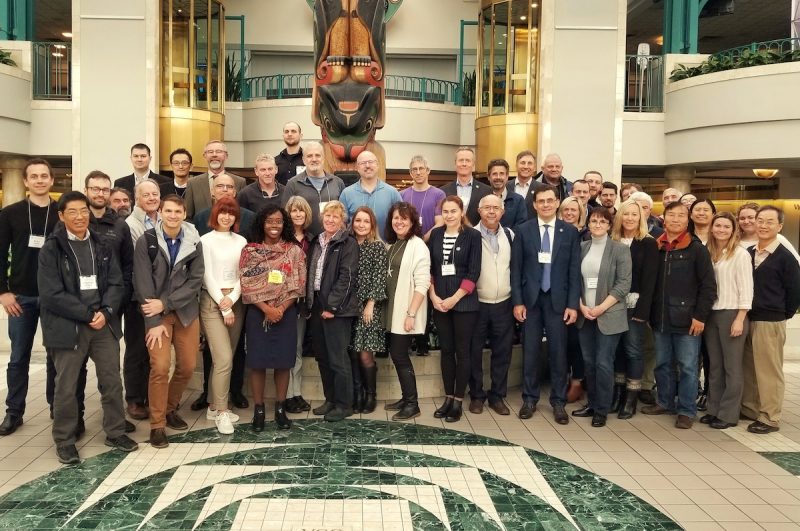Salmon sleuths plan another expedition to uncover secrets of the sea
“While we know a fair amount about the lives of salmon close to shore and in our rivers and streams we really don’t know much about their lives in the open ocean” John Paul Fraser, B.C. Salmon Farmers Association.
By Fabian Dawson
SeaWestNews
B.C’s fish farmers will be among several groups stepping up to fund another expedition to study the secret lives of salmon in the high seas.
The new expedition will employ up to five research vessels operating simultaneously to survey the full breadth of the North Pacific Ocean (NPO) in winter 2021.
These vessels will carry leading scientists from Canada, Japan, Korea, Russia and the United States, committed to answering questions about the mechanisms affecting the productivity and distribution of salmon.
Earlier this year, the International Gulf of Alaska Expedition 2019 was completed with 21 scientific personnel from five Pacific Rim countries, aboard the chartered 62 m Russian R/V Professor Kaganovskiy.
This expedition, which spent over a month travelling 8,000 kilometres in the Pacific Northwest, established there are more salmon in the Pacific Ocean than at any time since 1925.
It was organised by Fisheries and Oceans Canada scientist emeritus Dr. Richard J. Beamish and sets a precedent for addressing gaps in our knowledge through survey work of salmon, plankton and physical conditions in the central Gulf of Alaska.
Both the 2019 and 2021 Expeditions are Signature Projects of the International Year of the Salmon (IYS).
The IYS is a five-year initiative (2018-2022) of The North Pacific Anadromous Fish Commission (NPAFC) and its North Atlantic partner, the North Atlantic Salmon Conservation Organization (NASCO) aiming to establish a new hemispheric-scale partnership of government, Indigenous Peoples, academia, NGOs and industry to effectively address the scientific and social challenges facing salmon and people in an increasingly uncertain environment.
Speaking to SeaWestNews, Dr. Beamish said one of the immediate priorities is to collate the data from the 2019 expedition, make it accessible for international input and publish it in a scientific journal.
“We have had some good response already for the second bigger expedition to build on the findings of the first one,” he said.
The scientists on the 2019 expedition surveyed 60 different locations in the Gulf of Alaska and estimated there are about 55 million salmon in the area, which is a feeding ground where the majority of Pacific salmon migrate to in the winter, Dr Beamish said.
In addition to private donations, Ottawa kicked in $250,000, the B.C. Salmon Farmers Association (BCSFA) contributed $200,000, The Pacific Salmon Foundation and the Pacific Salmon Commission came up with $250,000 and Victoria provided $75,000 for the $1.3 million 2019 study.
Last month, Dr Beamish was among the scientists who gathered in Victoria to explore findings from the ground-breaking 2019 winter expedition to the Gulf of Alaska and plan for a fully pan-Pacific expedition in March of 2021.
Mark Saunders, IYS Director for the North Pacific Region said: “At the present time national requests for vessels are being considered by Canada, United States, Russia, Japan and Korea.”
“The 2021 Expedition will provide a platform for international collaborative ecosystem research to monitor the distribution, abundance and productivity of salmon to directly inform fisheries management and enforcement decisions to be made in an increasingly uncertain future.”
John Paul Fraser, executive director of the B.C. Salmon Farmers Association said his members hold research, science and development as top priorities in maintaining a sustainable aquaculture industry.
“Anyone working with fish in our oceans should be interested in knowing more about them. While we know a fair amount about the lives of salmon close to shore and in our rivers and streams we really don’t know much about their lives in the open ocean, where they spend years before returning to spawning grounds.
“Dr. Beamish’s first expedition early this year started filling in that gap, but there’s a lot more research to do and further expeditions are important. We supported the first expedition, and are looking at how we can support the ongoing efforts,” he told SeaWestNews.
(Image – Some of the scientists who gathered in Victoria last month to explore findings from the ground-breaking 2019 winter expedition to the Gulf of Alaska and plan for a fully pan-Pacific expedition in March of 2021. Courtesy of NPAFC)

